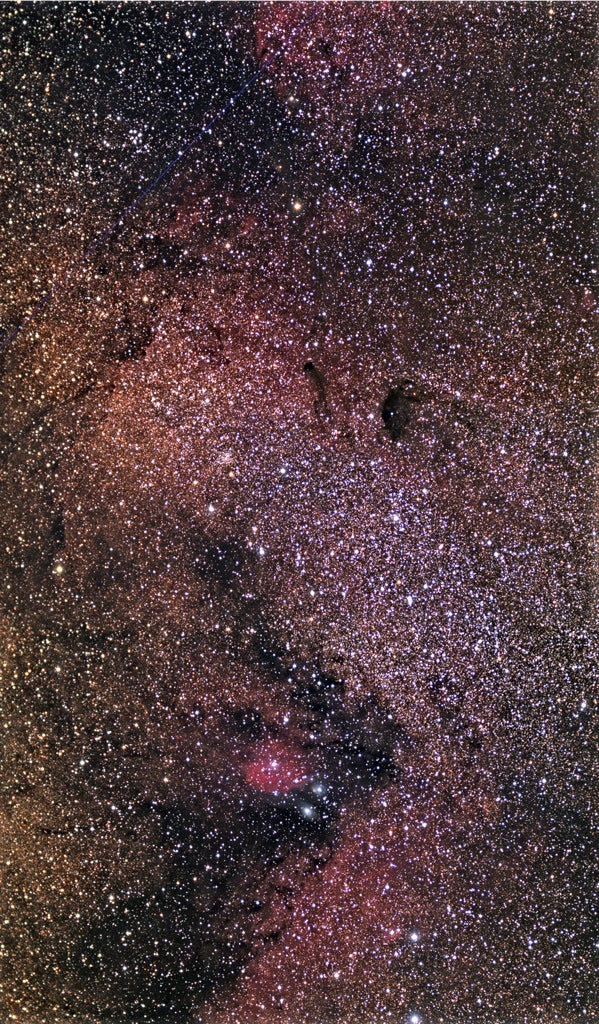Let’s begin in the shadow of 1st-magnitude Antares in Scorpius. Aim your binoculars a degree west of this red supergiant star and you’ll find globular cluster M4. This collection of more than 100,000 ancient suns looks like a faint ball of celestial cotton through most instruments, although large binoculars begin to resolve some stars around its edge. M4 resides at the vertex of an obtuse triangle formed with Antares and 3rd-magnitude Sigma (σ) Scorpii. By the way, Antares itself is a striking sight through binoculars from the Northern Hemisphere because it shimmers with a kaleidoscope of colors thanks to the turbulence in Earth’s atmosphere.
Next, shift about 25° east to target the Small Sagittarius Star Cloud (M24). Under dark skies, M24 shows up to naked eyes as a brighter patch of Milky Way located about two binocular fields north of the “spout” in Sagittarius’ Teapot asterism. Binoculars resolve M24 into countless points of light. Despite its name, this object is not really a single group of stars. When looking in its direction, we actually peer through a clearing in the Milky Way’s interstellar dust to the next spiral arm inward. Take several minutes to enjoy this taste of our galaxy’s inner regions.
Scan about one binocular field west of M24 and you’ll bump into open cluster M23. Through 50mm binoculars, the cluster looks like a hazy patch of light about the size of the Full Moon. Look carefully and you might make out a few of the 150 or so stars that call M23 home. An unrelated 6th-magnitude star, SAO 160909, lies just beyond the cluster’s northwestern edge.
Look an equal distance east of M24 and you’ll encounter another fine open cluster: M25. This star group appears conspicuous through binoculars of nearly any size. Although its dimension matches that of M23, M25 reveals fewer individual stars. Its brightest star, however, is a real attention-getter.
U Sagittarii belongs to the class known as Cepheid variable stars. During a period of 6 days and 18 hours, U Sgr varies from magnitude 6.3 to 7.1 and back again. Although the brightness change is rather subtle through binoculars, you might notice the star’s yellowish tint.
Swing your binoculars north toward the sprawling constellation Ophiuchus. Center them on 3rd-magnitude Cebalrai (Beta [β] Ophiuchi), which marks the left (northeast) shoulder of the Serpent-bearer, and pan about a field of view to the east. Do you see a V-shaped group of stars spanning nearly the entire field and looking a lot like the Hyades cluster in Taurus? If so, you have netted Taurus Poniatovii, or Poniatowski’s Bull. In 1777, Polish astronomer Martin Poczobut proposed these stars as a constellation and named it for King Stanislas Poniatowski II of Poland. Although the constellation never caught on, the summer bull remains a treat to see through binoculars.
Next, return to Cebalrai and look about 1° to the north-northeast for a swarm of faint suns. This is IC 4665, one of my favorite unsung open clusters of the summer sky. IC 4665 resolves into a stunning collection of about three dozen stars through even the smallest binoculars. It’s beyond me how Charles Messier and his compatriot Pierre Méchain could have missed this beauty.
Scan 13° due east of IC 4665 and you’ll alight on another overlooked open cluster: IC 4756 in Serpens. This group hosts 80 faint suns scattered across a diameter nearly twice that of the Full Moon. Together, they blur into a faint mist against a starry backdrop. The best views come through 14×70 or 16×70 binoculars, both of which have the aperture to resolve many of the cluster’s faint stars but still offer fields wide enough to take in the whole group. Although my 20x80s reveal still-fainter stars, the narrower field dilutes the impression of a cluster.
Look 3° west-northwest of IC 4756 to find NGC 6633. (Both open clusters should fit into the same field.) While IC 4756 appears quite faint through 10×50 binoculars, NGC 6633 stands out. Most of its 30 stars shine bright enough to show as faint pinpricks of light. Together, they create a rich swarm of glimmering blue-white gems set against the soft glow of the few cluster members left unresolved.
NGC 6940 is another underappreciated summer target that appears conspicuous once you spot it. This open cluster lies just inside the northern border of Vulpecula, 6° south-southwest of 2nd-magnitude Epsilon (ε) Cygni. NGC 6940’s football-shaped glow measures 0.4° across and looks like a detached piece of the Milky Way. It shows up nicely even from moderately light-polluted suburban skies. And if you look carefully, you might even see a few faint stars poking out from within.
Our final stop takes us far to the north, to the long and meandering constellation Draco. Although most of the Dragon’s stars glow inconspicuously, the four stars that make up its head stand out. Swing your binoculars to Nu (ν) Draconis, the faintest of the four and the one marking the northwestern corner, and you will be greeted by a pretty pair of 5th-magnitude white suns. Many observers call these the “Cat’s Eyes,” although they impress me more as a pair of distant car headlights. A full arcminute separates these stars, so 6-power pocket binoculars can resolve them.
These 10 targets represent just a small sample of the binocular delights awaiting you in the summer sky. Once evening twilight fades, pull out a chaise lounge, spray on some insect repellent, and get ready to enjoy magnificent views. You’ll quickly discover why I always say that two eyes are better than one.










